University of Westminster: Organisation Management Case Study Analysis
VerifiedAdded on 2022/08/01
|8
|2570
|47
Case Study
AI Summary
This case study analyzes the managerial and operational issues within a clothing company, focusing on its organizational culture, employee management, and leadership styles. The report identifies problems such as inadequate training, employee dissatisfaction due to poor working conditions and contracts, and a centralized organizational structure. It suggests solutions including adopting a democratic leadership style, decentralizing the organizational structure, improving employee training and development programs, and revising employee contracts to focus on satisfaction. The analysis emphasizes the importance of effective communication, strong employer-employee relations, and a culture that promotes organizational development and stakeholder well-being. The study concludes by highlighting the need for the company to prioritize employee needs and ethical practices to improve performance and achieve its strategic goals, ensuring long-term sustainability within the industry.
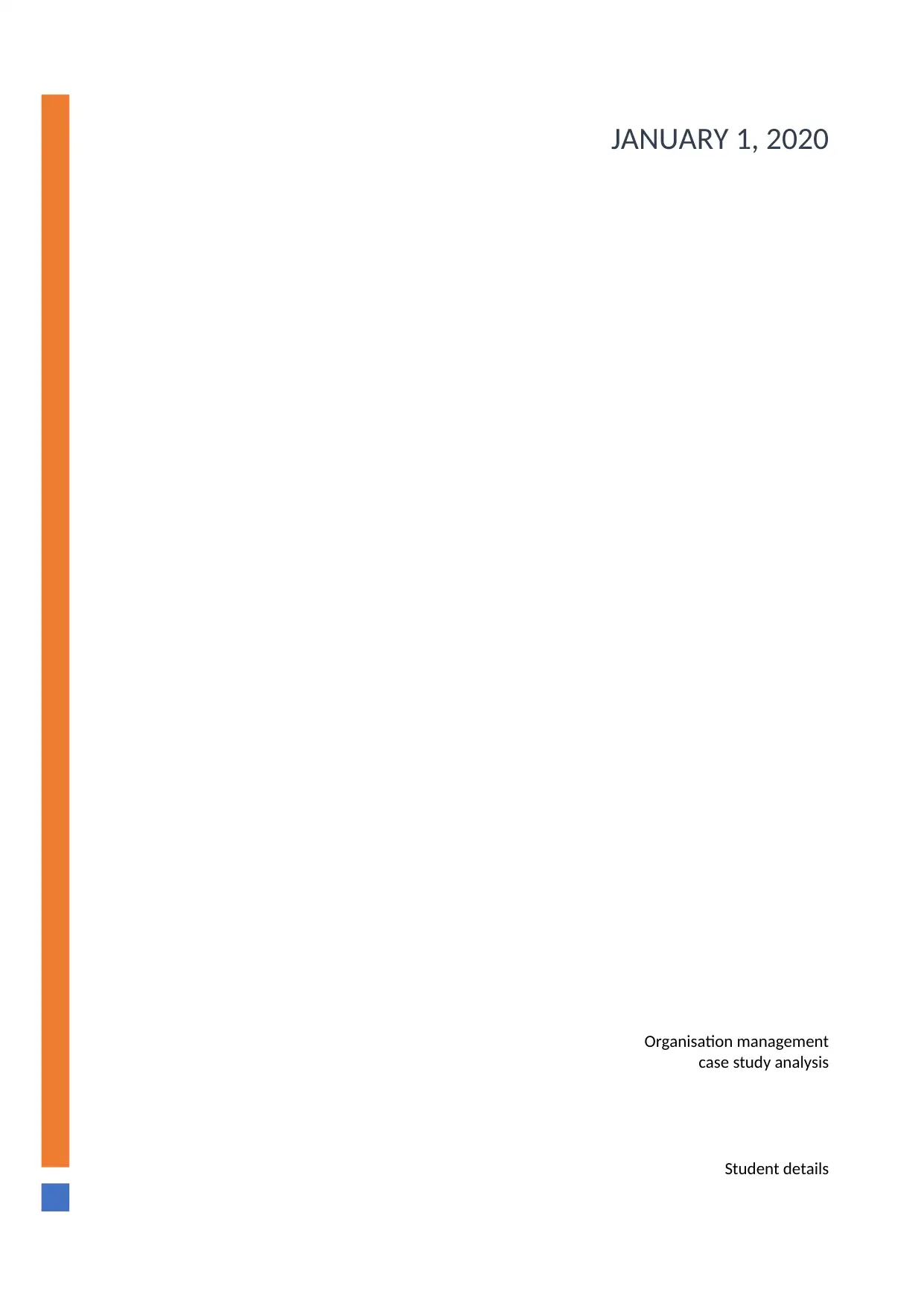
Organisation management
case study analysis
Student details
JANUARY 1, 2020
case study analysis
Student details
JANUARY 1, 2020
Paraphrase This Document
Need a fresh take? Get an instant paraphrase of this document with our AI Paraphraser
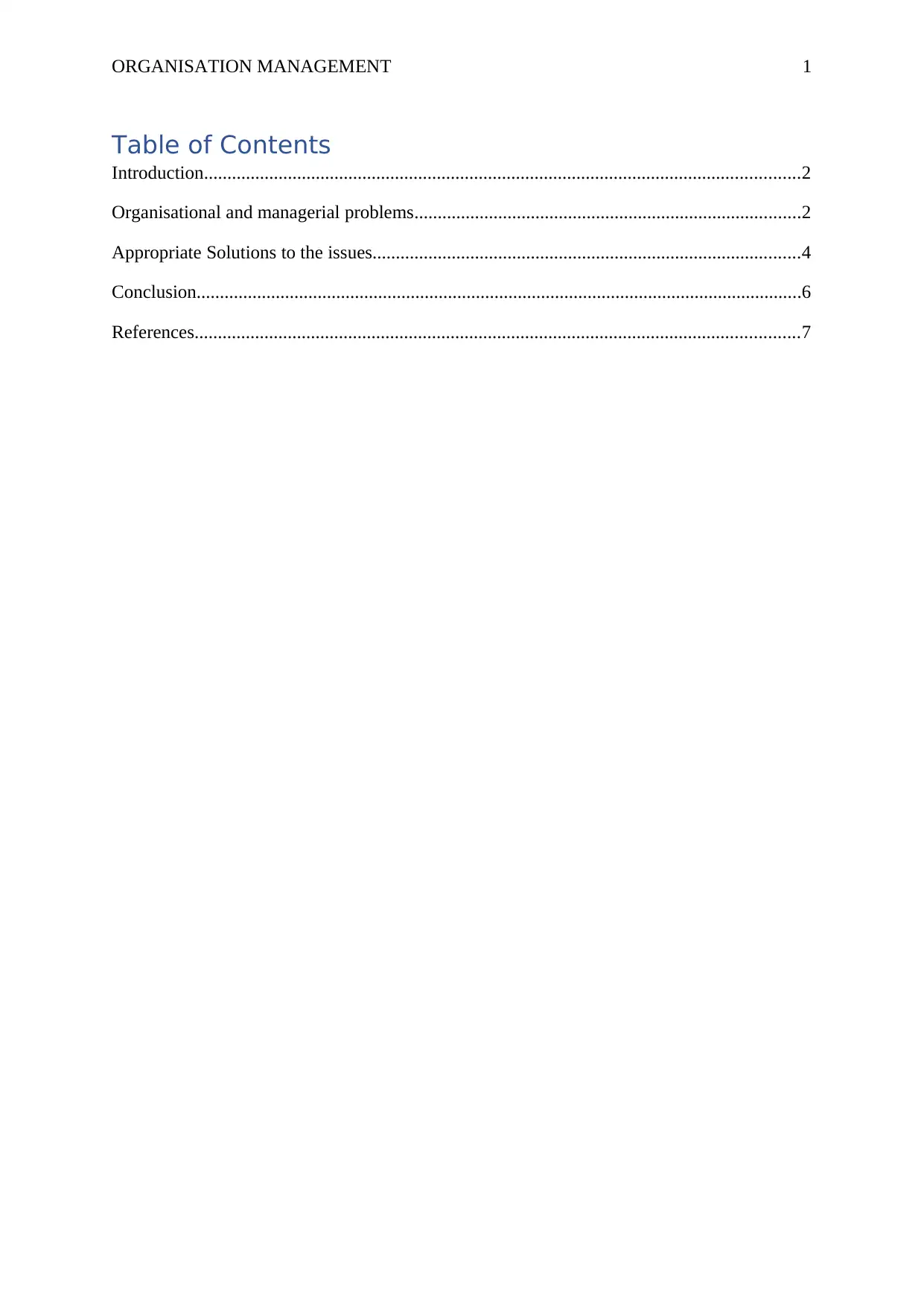
ORGANISATION MANAGEMENT 1
Table of Contents
Introduction................................................................................................................................2
Organisational and managerial problems...................................................................................2
Appropriate Solutions to the issues............................................................................................4
Conclusion..................................................................................................................................6
References..................................................................................................................................7
Table of Contents
Introduction................................................................................................................................2
Organisational and managerial problems...................................................................................2
Appropriate Solutions to the issues............................................................................................4
Conclusion..................................................................................................................................6
References..................................................................................................................................7
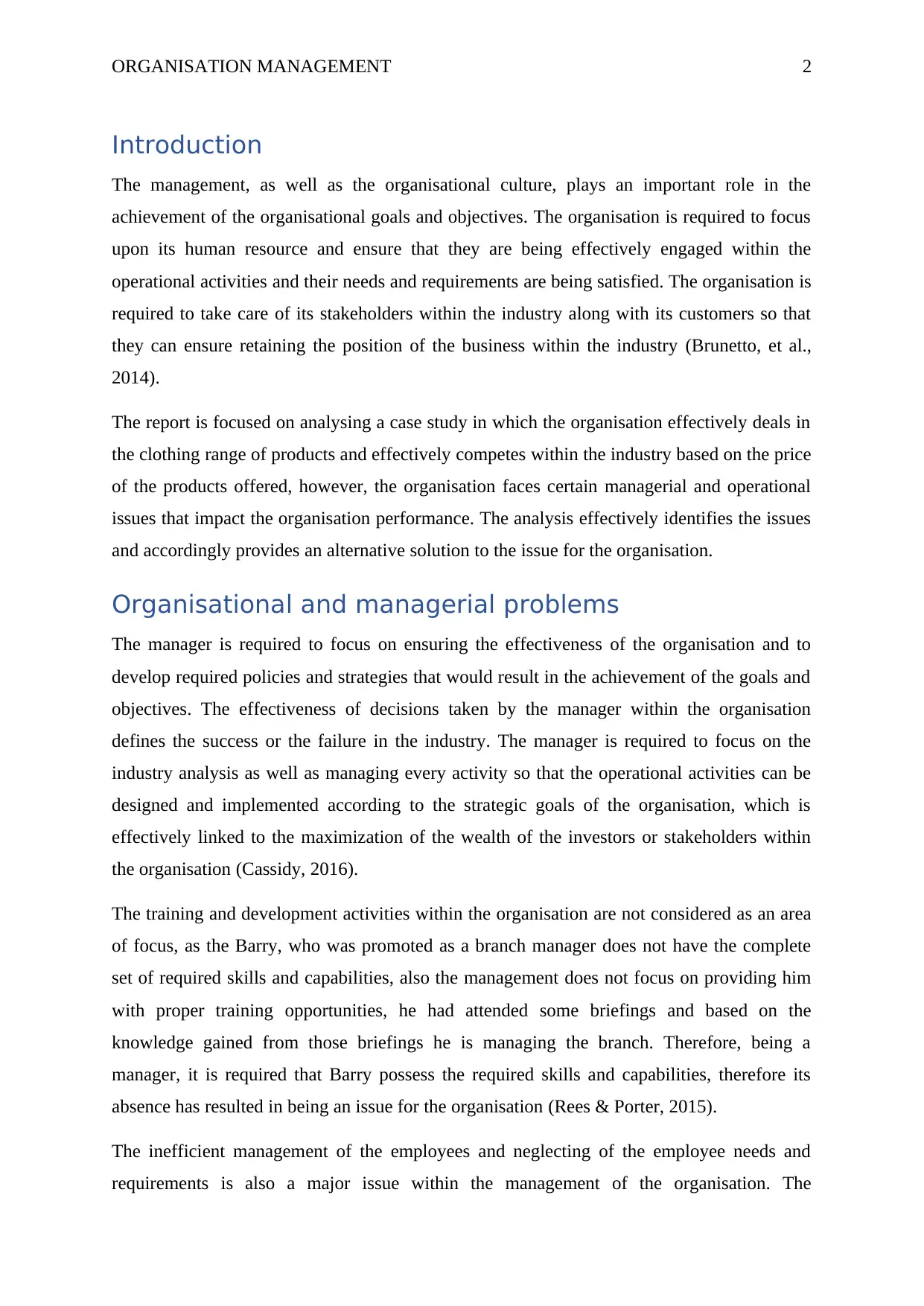
ORGANISATION MANAGEMENT 2
Introduction
The management, as well as the organisational culture, plays an important role in the
achievement of the organisational goals and objectives. The organisation is required to focus
upon its human resource and ensure that they are being effectively engaged within the
operational activities and their needs and requirements are being satisfied. The organisation is
required to take care of its stakeholders within the industry along with its customers so that
they can ensure retaining the position of the business within the industry (Brunetto, et al.,
2014).
The report is focused on analysing a case study in which the organisation effectively deals in
the clothing range of products and effectively competes within the industry based on the price
of the products offered, however, the organisation faces certain managerial and operational
issues that impact the organisation performance. The analysis effectively identifies the issues
and accordingly provides an alternative solution to the issue for the organisation.
Organisational and managerial problems
The manager is required to focus on ensuring the effectiveness of the organisation and to
develop required policies and strategies that would result in the achievement of the goals and
objectives. The effectiveness of decisions taken by the manager within the organisation
defines the success or the failure in the industry. The manager is required to focus on the
industry analysis as well as managing every activity so that the operational activities can be
designed and implemented according to the strategic goals of the organisation, which is
effectively linked to the maximization of the wealth of the investors or stakeholders within
the organisation (Cassidy, 2016).
The training and development activities within the organisation are not considered as an area
of focus, as the Barry, who was promoted as a branch manager does not have the complete
set of required skills and capabilities, also the management does not focus on providing him
with proper training opportunities, he had attended some briefings and based on the
knowledge gained from those briefings he is managing the branch. Therefore, being a
manager, it is required that Barry possess the required skills and capabilities, therefore its
absence has resulted in being an issue for the organisation (Rees & Porter, 2015).
The inefficient management of the employees and neglecting of the employee needs and
requirements is also a major issue within the management of the organisation. The
Introduction
The management, as well as the organisational culture, plays an important role in the
achievement of the organisational goals and objectives. The organisation is required to focus
upon its human resource and ensure that they are being effectively engaged within the
operational activities and their needs and requirements are being satisfied. The organisation is
required to take care of its stakeholders within the industry along with its customers so that
they can ensure retaining the position of the business within the industry (Brunetto, et al.,
2014).
The report is focused on analysing a case study in which the organisation effectively deals in
the clothing range of products and effectively competes within the industry based on the price
of the products offered, however, the organisation faces certain managerial and operational
issues that impact the organisation performance. The analysis effectively identifies the issues
and accordingly provides an alternative solution to the issue for the organisation.
Organisational and managerial problems
The manager is required to focus on ensuring the effectiveness of the organisation and to
develop required policies and strategies that would result in the achievement of the goals and
objectives. The effectiveness of decisions taken by the manager within the organisation
defines the success or the failure in the industry. The manager is required to focus on the
industry analysis as well as managing every activity so that the operational activities can be
designed and implemented according to the strategic goals of the organisation, which is
effectively linked to the maximization of the wealth of the investors or stakeholders within
the organisation (Cassidy, 2016).
The training and development activities within the organisation are not considered as an area
of focus, as the Barry, who was promoted as a branch manager does not have the complete
set of required skills and capabilities, also the management does not focus on providing him
with proper training opportunities, he had attended some briefings and based on the
knowledge gained from those briefings he is managing the branch. Therefore, being a
manager, it is required that Barry possess the required skills and capabilities, therefore its
absence has resulted in being an issue for the organisation (Rees & Porter, 2015).
The inefficient management of the employees and neglecting of the employee needs and
requirements is also a major issue within the management of the organisation. The
⊘ This is a preview!⊘
Do you want full access?
Subscribe today to unlock all pages.

Trusted by 1+ million students worldwide
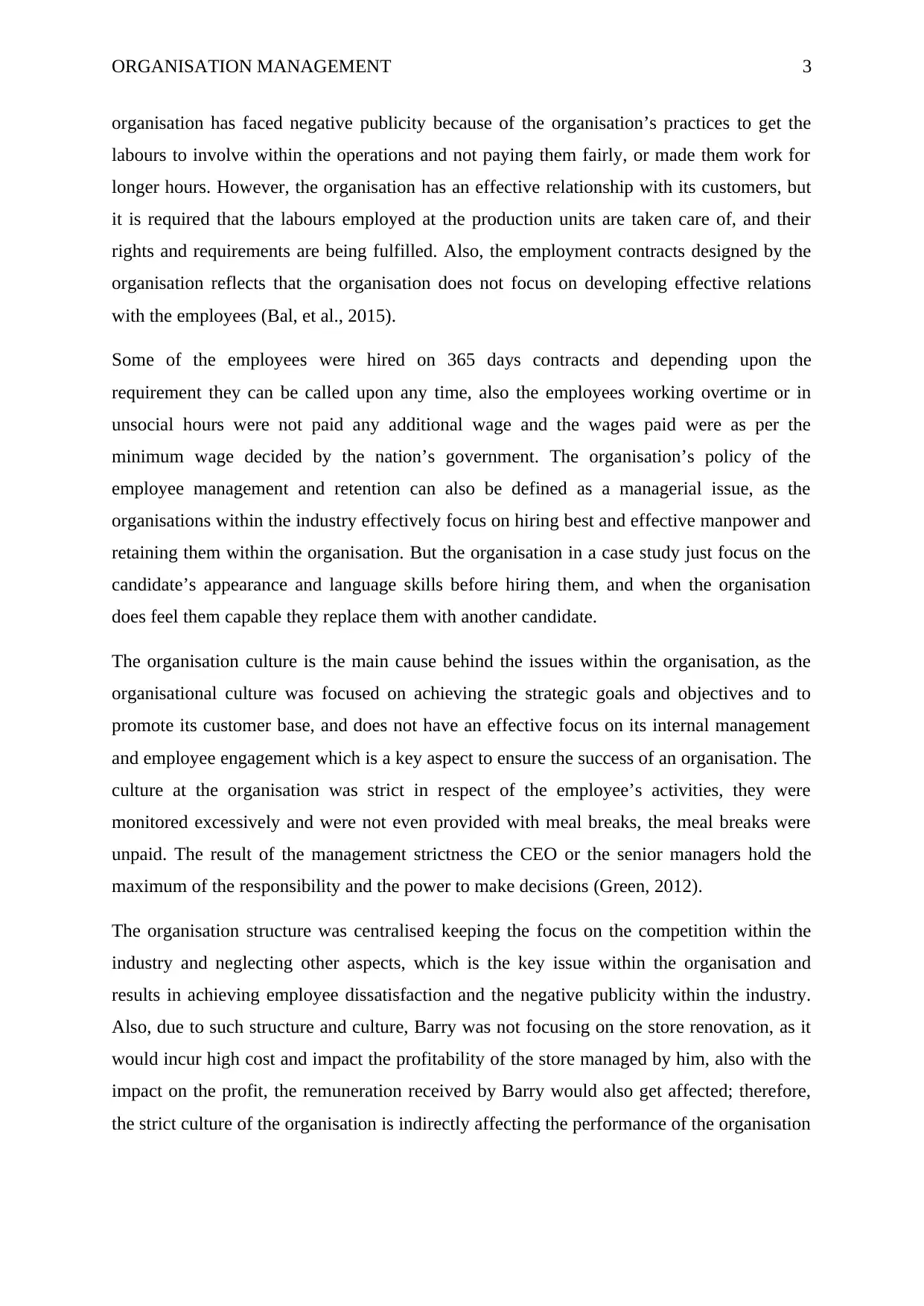
ORGANISATION MANAGEMENT 3
organisation has faced negative publicity because of the organisation’s practices to get the
labours to involve within the operations and not paying them fairly, or made them work for
longer hours. However, the organisation has an effective relationship with its customers, but
it is required that the labours employed at the production units are taken care of, and their
rights and requirements are being fulfilled. Also, the employment contracts designed by the
organisation reflects that the organisation does not focus on developing effective relations
with the employees (Bal, et al., 2015).
Some of the employees were hired on 365 days contracts and depending upon the
requirement they can be called upon any time, also the employees working overtime or in
unsocial hours were not paid any additional wage and the wages paid were as per the
minimum wage decided by the nation’s government. The organisation’s policy of the
employee management and retention can also be defined as a managerial issue, as the
organisations within the industry effectively focus on hiring best and effective manpower and
retaining them within the organisation. But the organisation in a case study just focus on the
candidate’s appearance and language skills before hiring them, and when the organisation
does feel them capable they replace them with another candidate.
The organisation culture is the main cause behind the issues within the organisation, as the
organisational culture was focused on achieving the strategic goals and objectives and to
promote its customer base, and does not have an effective focus on its internal management
and employee engagement which is a key aspect to ensure the success of an organisation. The
culture at the organisation was strict in respect of the employee’s activities, they were
monitored excessively and were not even provided with meal breaks, the meal breaks were
unpaid. The result of the management strictness the CEO or the senior managers hold the
maximum of the responsibility and the power to make decisions (Green, 2012).
The organisation structure was centralised keeping the focus on the competition within the
industry and neglecting other aspects, which is the key issue within the organisation and
results in achieving employee dissatisfaction and the negative publicity within the industry.
Also, due to such structure and culture, Barry was not focusing on the store renovation, as it
would incur high cost and impact the profitability of the store managed by him, also with the
impact on the profit, the remuneration received by Barry would also get affected; therefore,
the strict culture of the organisation is indirectly affecting the performance of the organisation
organisation has faced negative publicity because of the organisation’s practices to get the
labours to involve within the operations and not paying them fairly, or made them work for
longer hours. However, the organisation has an effective relationship with its customers, but
it is required that the labours employed at the production units are taken care of, and their
rights and requirements are being fulfilled. Also, the employment contracts designed by the
organisation reflects that the organisation does not focus on developing effective relations
with the employees (Bal, et al., 2015).
Some of the employees were hired on 365 days contracts and depending upon the
requirement they can be called upon any time, also the employees working overtime or in
unsocial hours were not paid any additional wage and the wages paid were as per the
minimum wage decided by the nation’s government. The organisation’s policy of the
employee management and retention can also be defined as a managerial issue, as the
organisations within the industry effectively focus on hiring best and effective manpower and
retaining them within the organisation. But the organisation in a case study just focus on the
candidate’s appearance and language skills before hiring them, and when the organisation
does feel them capable they replace them with another candidate.
The organisation culture is the main cause behind the issues within the organisation, as the
organisational culture was focused on achieving the strategic goals and objectives and to
promote its customer base, and does not have an effective focus on its internal management
and employee engagement which is a key aspect to ensure the success of an organisation. The
culture at the organisation was strict in respect of the employee’s activities, they were
monitored excessively and were not even provided with meal breaks, the meal breaks were
unpaid. The result of the management strictness the CEO or the senior managers hold the
maximum of the responsibility and the power to make decisions (Green, 2012).
The organisation structure was centralised keeping the focus on the competition within the
industry and neglecting other aspects, which is the key issue within the organisation and
results in achieving employee dissatisfaction and the negative publicity within the industry.
Also, due to such structure and culture, Barry was not focusing on the store renovation, as it
would incur high cost and impact the profitability of the store managed by him, also with the
impact on the profit, the remuneration received by Barry would also get affected; therefore,
the strict culture of the organisation is indirectly affecting the performance of the organisation
Paraphrase This Document
Need a fresh take? Get an instant paraphrase of this document with our AI Paraphraser
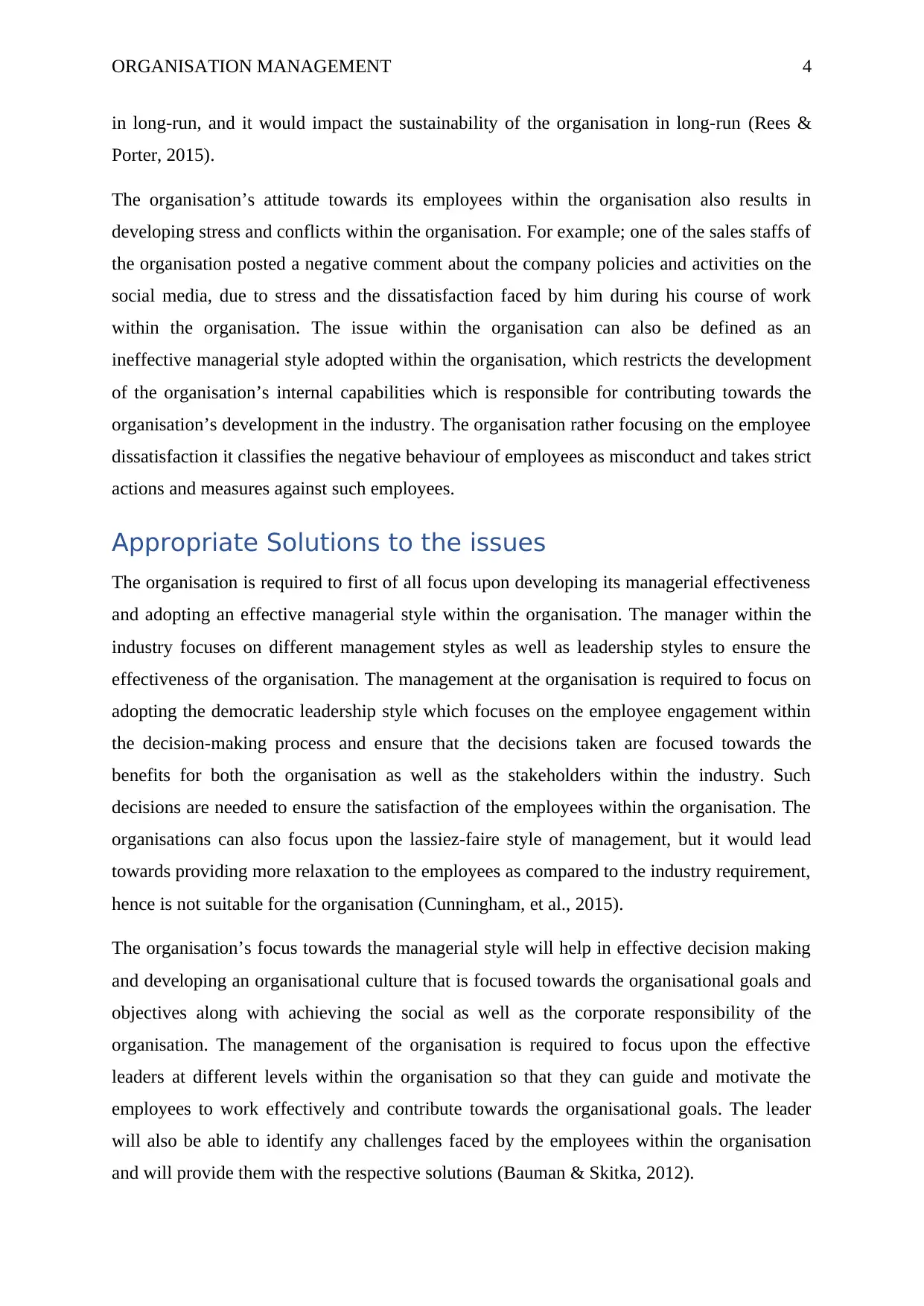
ORGANISATION MANAGEMENT 4
in long-run, and it would impact the sustainability of the organisation in long-run (Rees &
Porter, 2015).
The organisation’s attitude towards its employees within the organisation also results in
developing stress and conflicts within the organisation. For example; one of the sales staffs of
the organisation posted a negative comment about the company policies and activities on the
social media, due to stress and the dissatisfaction faced by him during his course of work
within the organisation. The issue within the organisation can also be defined as an
ineffective managerial style adopted within the organisation, which restricts the development
of the organisation’s internal capabilities which is responsible for contributing towards the
organisation’s development in the industry. The organisation rather focusing on the employee
dissatisfaction it classifies the negative behaviour of employees as misconduct and takes strict
actions and measures against such employees.
Appropriate Solutions to the issues
The organisation is required to first of all focus upon developing its managerial effectiveness
and adopting an effective managerial style within the organisation. The manager within the
industry focuses on different management styles as well as leadership styles to ensure the
effectiveness of the organisation. The management at the organisation is required to focus on
adopting the democratic leadership style which focuses on the employee engagement within
the decision-making process and ensure that the decisions taken are focused towards the
benefits for both the organisation as well as the stakeholders within the industry. Such
decisions are needed to ensure the satisfaction of the employees within the organisation. The
organisations can also focus upon the lassiez-faire style of management, but it would lead
towards providing more relaxation to the employees as compared to the industry requirement,
hence is not suitable for the organisation (Cunningham, et al., 2015).
The organisation’s focus towards the managerial style will help in effective decision making
and developing an organisational culture that is focused towards the organisational goals and
objectives along with achieving the social as well as the corporate responsibility of the
organisation. The management of the organisation is required to focus upon the effective
leaders at different levels within the organisation so that they can guide and motivate the
employees to work effectively and contribute towards the organisational goals. The leader
will also be able to identify any challenges faced by the employees within the organisation
and will provide them with the respective solutions (Bauman & Skitka, 2012).
in long-run, and it would impact the sustainability of the organisation in long-run (Rees &
Porter, 2015).
The organisation’s attitude towards its employees within the organisation also results in
developing stress and conflicts within the organisation. For example; one of the sales staffs of
the organisation posted a negative comment about the company policies and activities on the
social media, due to stress and the dissatisfaction faced by him during his course of work
within the organisation. The issue within the organisation can also be defined as an
ineffective managerial style adopted within the organisation, which restricts the development
of the organisation’s internal capabilities which is responsible for contributing towards the
organisation’s development in the industry. The organisation rather focusing on the employee
dissatisfaction it classifies the negative behaviour of employees as misconduct and takes strict
actions and measures against such employees.
Appropriate Solutions to the issues
The organisation is required to first of all focus upon developing its managerial effectiveness
and adopting an effective managerial style within the organisation. The manager within the
industry focuses on different management styles as well as leadership styles to ensure the
effectiveness of the organisation. The management at the organisation is required to focus on
adopting the democratic leadership style which focuses on the employee engagement within
the decision-making process and ensure that the decisions taken are focused towards the
benefits for both the organisation as well as the stakeholders within the industry. Such
decisions are needed to ensure the satisfaction of the employees within the organisation. The
organisations can also focus upon the lassiez-faire style of management, but it would lead
towards providing more relaxation to the employees as compared to the industry requirement,
hence is not suitable for the organisation (Cunningham, et al., 2015).
The organisation’s focus towards the managerial style will help in effective decision making
and developing an organisational culture that is focused towards the organisational goals and
objectives along with achieving the social as well as the corporate responsibility of the
organisation. The management of the organisation is required to focus upon the effective
leaders at different levels within the organisation so that they can guide and motivate the
employees to work effectively and contribute towards the organisational goals. The leader
will also be able to identify any challenges faced by the employees within the organisation
and will provide them with the respective solutions (Bauman & Skitka, 2012).
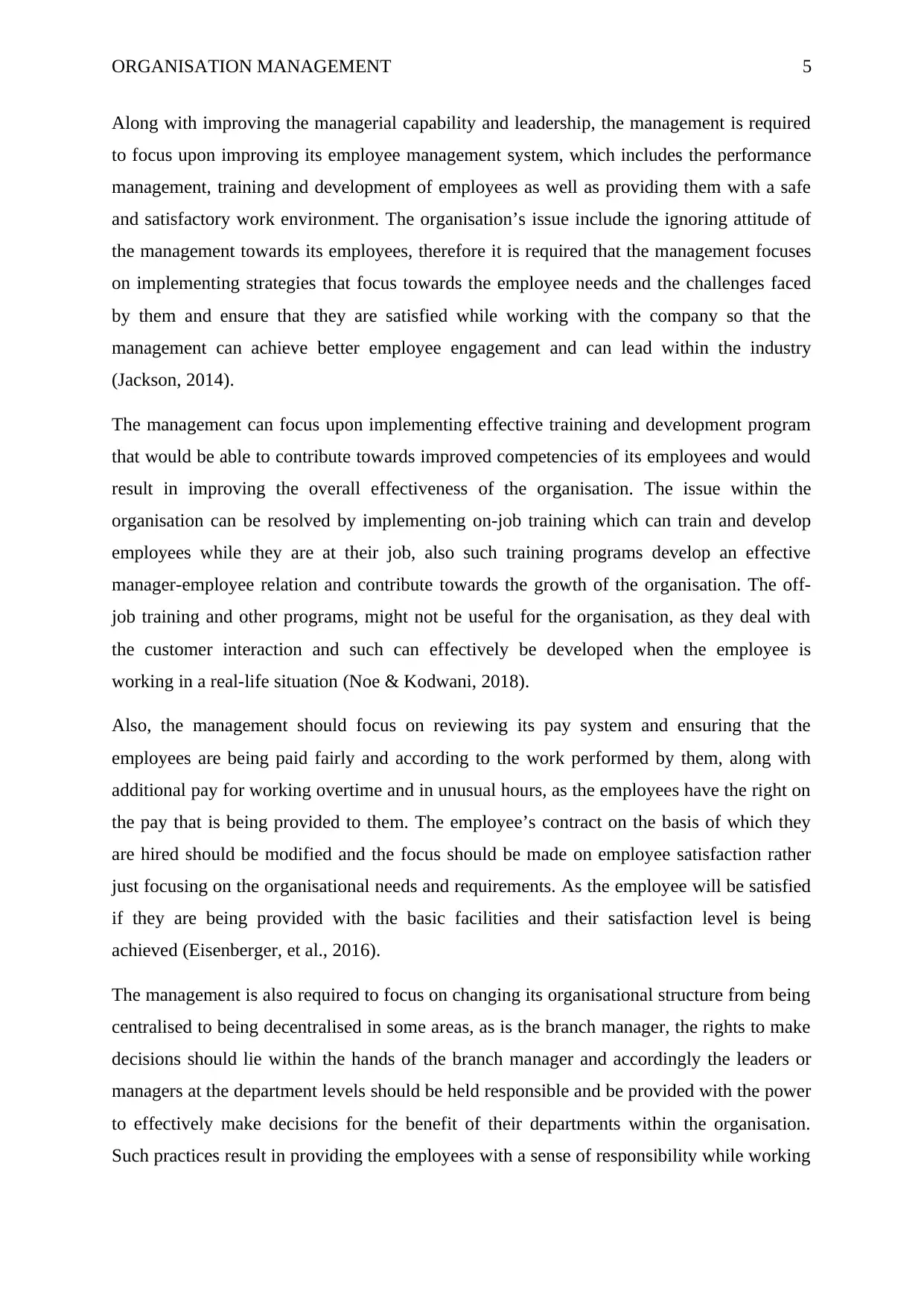
ORGANISATION MANAGEMENT 5
Along with improving the managerial capability and leadership, the management is required
to focus upon improving its employee management system, which includes the performance
management, training and development of employees as well as providing them with a safe
and satisfactory work environment. The organisation’s issue include the ignoring attitude of
the management towards its employees, therefore it is required that the management focuses
on implementing strategies that focus towards the employee needs and the challenges faced
by them and ensure that they are satisfied while working with the company so that the
management can achieve better employee engagement and can lead within the industry
(Jackson, 2014).
The management can focus upon implementing effective training and development program
that would be able to contribute towards improved competencies of its employees and would
result in improving the overall effectiveness of the organisation. The issue within the
organisation can be resolved by implementing on-job training which can train and develop
employees while they are at their job, also such training programs develop an effective
manager-employee relation and contribute towards the growth of the organisation. The off-
job training and other programs, might not be useful for the organisation, as they deal with
the customer interaction and such can effectively be developed when the employee is
working in a real-life situation (Noe & Kodwani, 2018).
Also, the management should focus on reviewing its pay system and ensuring that the
employees are being paid fairly and according to the work performed by them, along with
additional pay for working overtime and in unusual hours, as the employees have the right on
the pay that is being provided to them. The employee’s contract on the basis of which they
are hired should be modified and the focus should be made on employee satisfaction rather
just focusing on the organisational needs and requirements. As the employee will be satisfied
if they are being provided with the basic facilities and their satisfaction level is being
achieved (Eisenberger, et al., 2016).
The management is also required to focus on changing its organisational structure from being
centralised to being decentralised in some areas, as is the branch manager, the rights to make
decisions should lie within the hands of the branch manager and accordingly the leaders or
managers at the department levels should be held responsible and be provided with the power
to effectively make decisions for the benefit of their departments within the organisation.
Such practices result in providing the employees with a sense of responsibility while working
Along with improving the managerial capability and leadership, the management is required
to focus upon improving its employee management system, which includes the performance
management, training and development of employees as well as providing them with a safe
and satisfactory work environment. The organisation’s issue include the ignoring attitude of
the management towards its employees, therefore it is required that the management focuses
on implementing strategies that focus towards the employee needs and the challenges faced
by them and ensure that they are satisfied while working with the company so that the
management can achieve better employee engagement and can lead within the industry
(Jackson, 2014).
The management can focus upon implementing effective training and development program
that would be able to contribute towards improved competencies of its employees and would
result in improving the overall effectiveness of the organisation. The issue within the
organisation can be resolved by implementing on-job training which can train and develop
employees while they are at their job, also such training programs develop an effective
manager-employee relation and contribute towards the growth of the organisation. The off-
job training and other programs, might not be useful for the organisation, as they deal with
the customer interaction and such can effectively be developed when the employee is
working in a real-life situation (Noe & Kodwani, 2018).
Also, the management should focus on reviewing its pay system and ensuring that the
employees are being paid fairly and according to the work performed by them, along with
additional pay for working overtime and in unusual hours, as the employees have the right on
the pay that is being provided to them. The employee’s contract on the basis of which they
are hired should be modified and the focus should be made on employee satisfaction rather
just focusing on the organisational needs and requirements. As the employee will be satisfied
if they are being provided with the basic facilities and their satisfaction level is being
achieved (Eisenberger, et al., 2016).
The management is also required to focus on changing its organisational structure from being
centralised to being decentralised in some areas, as is the branch manager, the rights to make
decisions should lie within the hands of the branch manager and accordingly the leaders or
managers at the department levels should be held responsible and be provided with the power
to effectively make decisions for the benefit of their departments within the organisation.
Such practices result in providing the employees with a sense of responsibility while working
⊘ This is a preview!⊘
Do you want full access?
Subscribe today to unlock all pages.

Trusted by 1+ million students worldwide
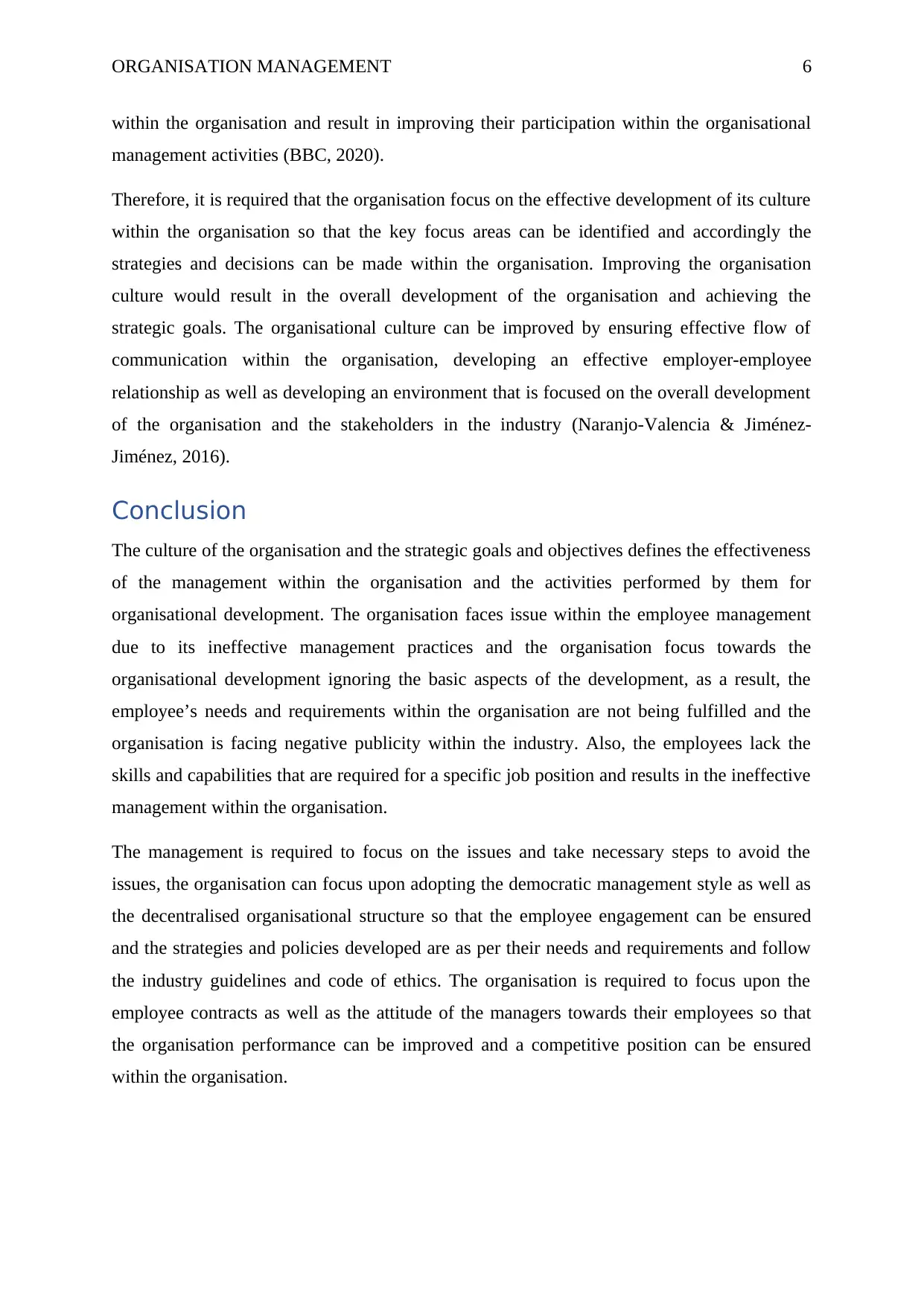
ORGANISATION MANAGEMENT 6
within the organisation and result in improving their participation within the organisational
management activities (BBC, 2020).
Therefore, it is required that the organisation focus on the effective development of its culture
within the organisation so that the key focus areas can be identified and accordingly the
strategies and decisions can be made within the organisation. Improving the organisation
culture would result in the overall development of the organisation and achieving the
strategic goals. The organisational culture can be improved by ensuring effective flow of
communication within the organisation, developing an effective employer-employee
relationship as well as developing an environment that is focused on the overall development
of the organisation and the stakeholders in the industry (Naranjo-Valencia & Jiménez-
Jiménez, 2016).
Conclusion
The culture of the organisation and the strategic goals and objectives defines the effectiveness
of the management within the organisation and the activities performed by them for
organisational development. The organisation faces issue within the employee management
due to its ineffective management practices and the organisation focus towards the
organisational development ignoring the basic aspects of the development, as a result, the
employee’s needs and requirements within the organisation are not being fulfilled and the
organisation is facing negative publicity within the industry. Also, the employees lack the
skills and capabilities that are required for a specific job position and results in the ineffective
management within the organisation.
The management is required to focus on the issues and take necessary steps to avoid the
issues, the organisation can focus upon adopting the democratic management style as well as
the decentralised organisational structure so that the employee engagement can be ensured
and the strategies and policies developed are as per their needs and requirements and follow
the industry guidelines and code of ethics. The organisation is required to focus upon the
employee contracts as well as the attitude of the managers towards their employees so that
the organisation performance can be improved and a competitive position can be ensured
within the organisation.
within the organisation and result in improving their participation within the organisational
management activities (BBC, 2020).
Therefore, it is required that the organisation focus on the effective development of its culture
within the organisation so that the key focus areas can be identified and accordingly the
strategies and decisions can be made within the organisation. Improving the organisation
culture would result in the overall development of the organisation and achieving the
strategic goals. The organisational culture can be improved by ensuring effective flow of
communication within the organisation, developing an effective employer-employee
relationship as well as developing an environment that is focused on the overall development
of the organisation and the stakeholders in the industry (Naranjo-Valencia & Jiménez-
Jiménez, 2016).
Conclusion
The culture of the organisation and the strategic goals and objectives defines the effectiveness
of the management within the organisation and the activities performed by them for
organisational development. The organisation faces issue within the employee management
due to its ineffective management practices and the organisation focus towards the
organisational development ignoring the basic aspects of the development, as a result, the
employee’s needs and requirements within the organisation are not being fulfilled and the
organisation is facing negative publicity within the industry. Also, the employees lack the
skills and capabilities that are required for a specific job position and results in the ineffective
management within the organisation.
The management is required to focus on the issues and take necessary steps to avoid the
issues, the organisation can focus upon adopting the democratic management style as well as
the decentralised organisational structure so that the employee engagement can be ensured
and the strategies and policies developed are as per their needs and requirements and follow
the industry guidelines and code of ethics. The organisation is required to focus upon the
employee contracts as well as the attitude of the managers towards their employees so that
the organisation performance can be improved and a competitive position can be ensured
within the organisation.
Paraphrase This Document
Need a fresh take? Get an instant paraphrase of this document with our AI Paraphraser
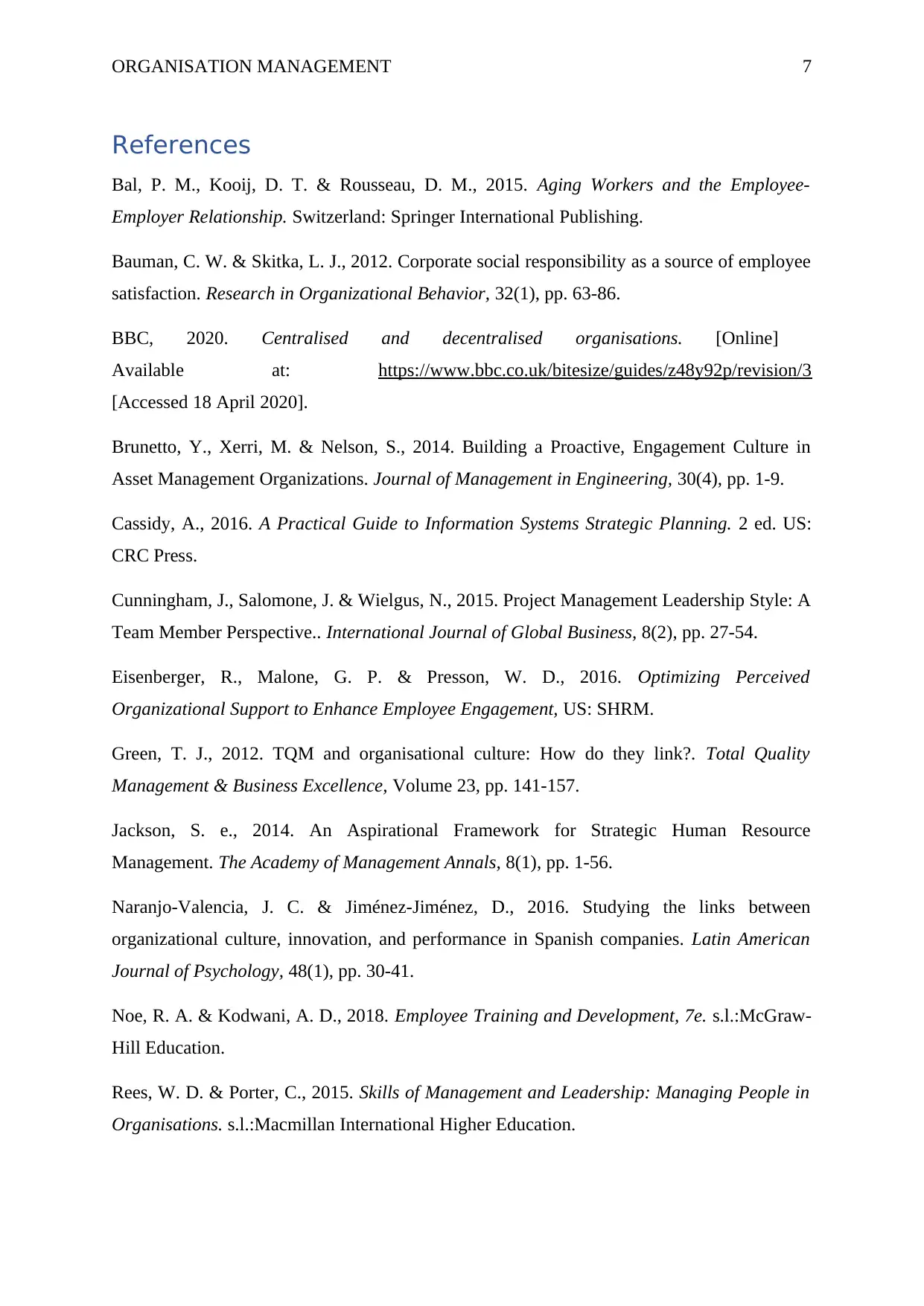
ORGANISATION MANAGEMENT 7
References
Bal, P. M., Kooij, D. T. & Rousseau, D. M., 2015. Aging Workers and the Employee-
Employer Relationship. Switzerland: Springer International Publishing.
Bauman, C. W. & Skitka, L. J., 2012. Corporate social responsibility as a source of employee
satisfaction. Research in Organizational Behavior, 32(1), pp. 63-86.
BBC, 2020. Centralised and decentralised organisations. [Online]
Available at: https://www.bbc.co.uk/bitesize/guides/z48y92p/revision/3
[Accessed 18 April 2020].
Brunetto, Y., Xerri, M. & Nelson, S., 2014. Building a Proactive, Engagement Culture in
Asset Management Organizations. Journal of Management in Engineering, 30(4), pp. 1-9.
Cassidy, A., 2016. A Practical Guide to Information Systems Strategic Planning. 2 ed. US:
CRC Press.
Cunningham, J., Salomone, J. & Wielgus, N., 2015. Project Management Leadership Style: A
Team Member Perspective.. International Journal of Global Business, 8(2), pp. 27-54.
Eisenberger, R., Malone, G. P. & Presson, W. D., 2016. Optimizing Perceived
Organizational Support to Enhance Employee Engagement, US: SHRM.
Green, T. J., 2012. TQM and organisational culture: How do they link?. Total Quality
Management & Business Excellence, Volume 23, pp. 141-157.
Jackson, S. e., 2014. An Aspirational Framework for Strategic Human Resource
Management. The Academy of Management Annals, 8(1), pp. 1-56.
Naranjo-Valencia, J. C. & Jiménez-Jiménez, D., 2016. Studying the links between
organizational culture, innovation, and performance in Spanish companies. Latin American
Journal of Psychology, 48(1), pp. 30-41.
Noe, R. A. & Kodwani, A. D., 2018. Employee Training and Development, 7e. s.l.:McGraw-
Hill Education.
Rees, W. D. & Porter, C., 2015. Skills of Management and Leadership: Managing People in
Organisations. s.l.:Macmillan International Higher Education.
References
Bal, P. M., Kooij, D. T. & Rousseau, D. M., 2015. Aging Workers and the Employee-
Employer Relationship. Switzerland: Springer International Publishing.
Bauman, C. W. & Skitka, L. J., 2012. Corporate social responsibility as a source of employee
satisfaction. Research in Organizational Behavior, 32(1), pp. 63-86.
BBC, 2020. Centralised and decentralised organisations. [Online]
Available at: https://www.bbc.co.uk/bitesize/guides/z48y92p/revision/3
[Accessed 18 April 2020].
Brunetto, Y., Xerri, M. & Nelson, S., 2014. Building a Proactive, Engagement Culture in
Asset Management Organizations. Journal of Management in Engineering, 30(4), pp. 1-9.
Cassidy, A., 2016. A Practical Guide to Information Systems Strategic Planning. 2 ed. US:
CRC Press.
Cunningham, J., Salomone, J. & Wielgus, N., 2015. Project Management Leadership Style: A
Team Member Perspective.. International Journal of Global Business, 8(2), pp. 27-54.
Eisenberger, R., Malone, G. P. & Presson, W. D., 2016. Optimizing Perceived
Organizational Support to Enhance Employee Engagement, US: SHRM.
Green, T. J., 2012. TQM and organisational culture: How do they link?. Total Quality
Management & Business Excellence, Volume 23, pp. 141-157.
Jackson, S. e., 2014. An Aspirational Framework for Strategic Human Resource
Management. The Academy of Management Annals, 8(1), pp. 1-56.
Naranjo-Valencia, J. C. & Jiménez-Jiménez, D., 2016. Studying the links between
organizational culture, innovation, and performance in Spanish companies. Latin American
Journal of Psychology, 48(1), pp. 30-41.
Noe, R. A. & Kodwani, A. D., 2018. Employee Training and Development, 7e. s.l.:McGraw-
Hill Education.
Rees, W. D. & Porter, C., 2015. Skills of Management and Leadership: Managing People in
Organisations. s.l.:Macmillan International Higher Education.
1 out of 8
Related Documents
Your All-in-One AI-Powered Toolkit for Academic Success.
+13062052269
info@desklib.com
Available 24*7 on WhatsApp / Email
![[object Object]](/_next/static/media/star-bottom.7253800d.svg)
Unlock your academic potential
Copyright © 2020–2025 A2Z Services. All Rights Reserved. Developed and managed by ZUCOL.




